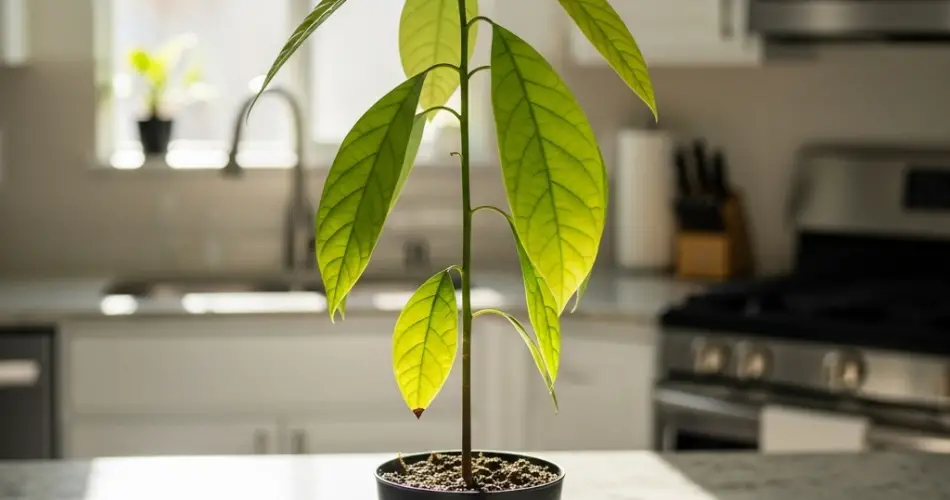Growing an avocado tree in a small apartment may seem ambitious, but with the right method and a bit of patience, it’s entirely possible. While indoor avocado trees won’t produce fruit as quickly—or as abundantly—as outdoor ones, they still make for attractive houseplants and can bring a touch of nature into any compact living space.
Whether you’re growing from a seed or starting with a small plant, here’s how to successfully nurture an avocado in your apartment.
1. Start With a Pit or a Young Plant
There are two main ways to begin your avocado-growing journey indoors:
-
From a seed: Save the pit from a ripe avocado. Rinse it gently and insert three or four toothpicks around its sides. Suspend it over a glass of water with the bottom (the broader end) submerged. Place the glass in a warm, sunny spot and change the water every few days. After 2–6 weeks, roots and a sprout will begin to appear.
-
From a nursery plant: If you prefer a quicker start, purchase a young avocado tree suited for indoor growth. Look for dwarf varieties such as ‘Wurtz’ or ‘Little Cado’, which are more manageable in small spaces.
2. Choose the Right Pot and Soil
Once your seed has developed roots or your nursery plant is ready to be potted, transfer it to a pot with proper drainage holes. Avocados do not tolerate soggy soil, so drainage is key.
Use a light, fast-draining potting mix. A mix formulated for citrus or cactus plants is ideal. You can also blend regular potting soil with sand or perlite to improve drainage.
Select a pot that is at least 10–12 inches in diameter. As the tree grows, you may need to repot it into a larger container every year or two.
3. Sunlight Is Essential
Avocado trees need plenty of bright, indirect sunlight to thrive. Position your plant near a south- or west-facing window where it can receive at least 6 hours of sunlight a day. If your apartment lacks strong natural light, consider using a grow light to supplement.
Keep in mind that without enough light, the plant will become leggy and weak. Rotate the pot every couple of weeks to ensure even growth on all sides.
4. Watering with Care
Avocado plants like to be kept evenly moist but not wet. Overwatering is one of the most common problems for indoor avocado trees.
Allow the top inch of soil to dry out before watering again. When you water, do so thoroughly, allowing excess water to drain out of the pot. Be sure to empty any saucers beneath the pot to prevent root rot.
During the winter months, when the plant’s growth slows, reduce the frequency of watering.
5. Feeding for Growth
Feed your avocado plant every 4–6 weeks during the growing season (spring through early fall) with a balanced, water-soluble fertilizer. A fertilizer high in nitrogen supports healthy leaf and stem growth.
Avoid fertilizing in the winter, as the plant will be dormant and won’t benefit from added nutrients during that time.
6. Pruning and Maintenance
To encourage a fuller, bushier shape, pinch back the growing tips when your avocado plant is about 12 inches tall. Regular pruning helps control height and encourages lateral branching, which is especially useful in small apartments.
Remove any yellow or damaged leaves to keep the plant healthy and attractive. Avocados can grow quickly, so regular pruning also helps manage their size indoors.
7. Pollination and Fruit Expectations
Indoor avocado trees may not bear fruit without proper pollination, and even then, it can take several years—if at all—for fruit to appear. Most avocado trees grown indoors are kept primarily for their ornamental value.
If you’re hoping for fruit, hand-pollination may help. Avocado flowers are unique and may require transferring pollen manually from one flower to another using a soft brush.
Still, be realistic—fruiting indoors is rare unless you have ideal conditions and a lot of patience.
8. Common Problems to Watch For
-
Leaf browning or curling: This may be due to low humidity or salt buildup from fertilizers. Mist the plant occasionally or wipe leaves with a damp cloth, and flush the soil every few months with water.
-
Pests: Watch for spider mites or aphids. If pests appear, treat with neem oil or an insecticidal soap spray.
-
Leggy growth: This often indicates low light. Adjust the plant’s location or provide supplemental lighting.
Final Thoughts
You don’t need a backyard to enjoy the beauty of an avocado plant. With the right setup, a bit of care, and an understanding of its needs, you can successfully grow and nurture an avocado tree even in the smallest of apartments. While fruiting may be a long shot indoors, the lush foliage alone makes the effort worthwhile—and the process is both fun and rewarding.



